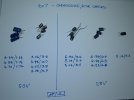Black Hole
May contain traces of nut
Dead rightthere's a limit to how much work the board will take before tracks start to lift
That would not be usual. The pre-applied solder paste keeps them in place, then the process of reflow eliminates any placement misalignment by the action of surface tension (in the molten solder). The components get pulled to the "centre of gravity" (for want of a better term) of the pad footprint.I think these SMD blighters have a little dot of glue on their underside which makes them more difficult to remove than might appear.
Something you might not have taken account of is that the solder is lead-free and thus requires more heat before it melts (greater hazard to the PCB). It's easier if you add some tin-lead solder first.





